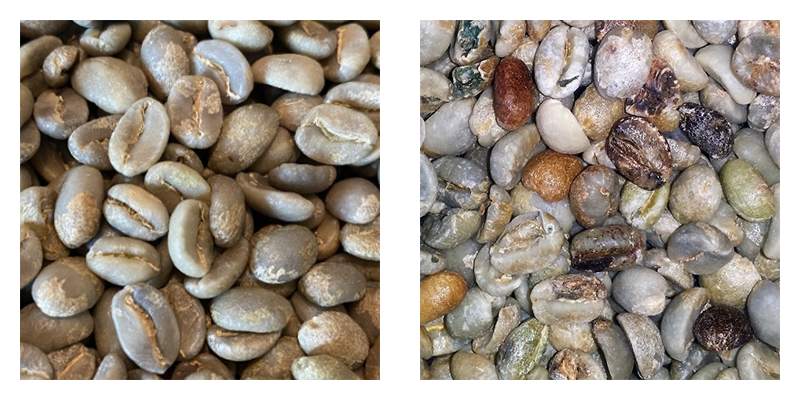Over the past few years, we have received a growing number of messages from customers who have food sensitivities, histamine intolerance, or Mast Cell Activation Syndrome (MCAS). These customers express how they need to limit the intake of various categories of foods or else suffer from painful reactions. Because coffee is a common trigger for those who struggle with histamine intolerance and MCAS, they are naturally overjoyed upon finally discovering a coffee that can be enjoyed without adverse effects. With certified organic mold free coffee, many of these individuals are able to enjoy their daily brew without triggering symptoms.
The following quotes represent a recent handful of the over one hundred messages we've received from relieved customers who are elated to be able to enjoy coffee once again...
"Love this coffee - I have histamine intolerance, so coffee is on a no-no list... except for this one. I can have my coffee with butter + MCT oil every morning with no issues. Tastes and smells great, too. I highly recommend.”
“I make a half-calf coffee with Purity because I have MCAS Histamine Intolerance, and this allows me to enjoy my morning coffee without mast cell symptoms.”
“I have a mast cell disorder and Purity decaf is the only coffee I have found that does not trigger a reaction. The customer service is awesome!”
“I have mycotoxin illness and found Purity Coffee through my functional medicine doctor and absolutely love the smooth, bold flavor. Ease doesn't leave an after taste and is the best coffee with the added benefit of being free of toxins and chemicals. I ran out of Ease and tried another brand I had on hand and had a mast cell reaction within 30 minutes of drinking. That absolutely proved it is toxin free and will not affect people with mast cell activation or chemical sensitivities. Thank you Purity for going the extra mile to create a delicious and healthy coffee!”
“Purity Coffee is hands down the best, cleanest, purest coffee I have ever drank! I have Mast Cell Activation Syndrome and have absolutely no issues drinking this coffee at all.”
“Finally a safe coffee I can enjoy as I have Mast Cell Activation Syndrome. Thank you for making this excellent product and giving me back my morning brew!”
We have been captivated by these comments and seek to understand what might be happening. This short, simplified literature review looks at the current state of scientific research on coffee and histamine specifically, and more generally on compounds in coffee that may cause reactions in those with Mast Cell Activation Syndrome (MCAS).
Summary of Scientific Findings Cited in this Article:
What is Histamine Intolerance?
Histamine intolerance does not mean a sensitivity to histamine, but an excess of histamine accumulated in the system. Histamine Intolerance often develops from a deficiency in the enzyme diamine oxidase (DAO), the main compound responsible for breaking down or metabolizing ingested histamine-rich food, alcohol, or drugs.
What is the Impact of Histamine Intolerance?
Histamine intolerance presents itself with frequent headaches, migraines, digestive problems, respiratory and gastrointestinal issues, fatigue, and anxiety, and can cause uncomfortable reactions in almost every system of the body.
What is Mast Cell Activation Syndrome (MCAS)?
The primary purpose of mast cells is to detect problems in the body and protect us. Mast cells are present throughout most of our bodies and secrete different chemicals during allergic reactions and infections. Mast cell activation syndrome (MCAS), however, causes a person to have repeated severe allergy symptoms and reactions that affect several body systems. In MCAS, mast cells release too many chemical agents, resulting in symptoms in the skin, gastrointestinal tract, heart, respiratory, and neurologic systems.
Symptoms can start at any age, but more recent theories suggest it's likely showing up in childhood but misdiagnosed or unrecognized until adulthood. The cause of MCAS is unknown, and sometimes those who suffer from it are unfairly dismissed as hypochondriacs or told that their symptoms are simply “in their heads.”
What is the Difference Between Histamine Intolerance and MCAS?
Because histamine intolerance implicates the mast cells, it is often confused with MCAS. The difference, however, is that MCAS is a complex situation that involves many different systems in the body. With MCAS the mast cells secrete several mediators in addition to histamine. In histamine intolerance, the body is struggling to break down the excess histamine because the histamine-degrading enzymes can't keep up with the histamine load. The mast cells are still releasing their 1000+ mediators, even if the body is in a state of histamine intolerance.
How Many People are Affected by Histamine Intolerance?
Although the exact number is not known, some estimates for those suffering from MCAS are as high as 17% of the population. Roughly 1% of the population appears to have histamine intolerance; of those, 80% are middle-aged.
What is the Link Between Coffee and Histamine?
Research on coffee and histamine is not extensive, but it all points to low-quality coffee and unripe coffee used in roasting. In high-quality coffee, histamine in green, roasted, and coffee beverages may not be found or may be present in small concentrations. However, even if concentrations are low, the presence of histamine could be enough to cause adverse effects in histamine-sensitive individuals or those with a higher load of amines that their bodies are trying to process.
Regarding other contaminants and compounds in low-quality coffee, several are likely to affect those with MCAS: Molds, mycotoxins, pesticide residues, yeasts, and other biogenic amines that are common in coffee, such as putrescine, cadaverine and others. All these can potentiate histamine toxicity and other stresses on the mast cells. Paying attention to all aspects of coffee brewing is also important: Water, equipment, filters, grinders and flasks all could produce reactions, rather than the coffee itself.
What Does Purity Coffee® do Differently that Limits Histamine or MCAS Reactions?
Only the top quality (called “specialty grade”), certified organic, hand-picked, ripened fruits are picked to ensure the coffee is not underripe or problematic. We test for antioxidants and other nutrients and choose coffees that are at high levels. We then roast conscientiously to retain as much antioxidant capacity as possible for each type of coffee. Finally, we employ strict food safety measures and current Good Manufacturing Practices (cGMPs).
We also lab test our coffees for pesticides, mold, mycotoxins, heavy metals, and other contaminants that could cause problems, prioritizing non toxic pesticide free coffee at every step. We only choose the cleanest and purest coffees.
All of our coffees are grown on regenerative organic farms, meeting the highest standards in the world for soil health. Although we cannot establish a direct link between our farming practices and the positive effect this might have on histamine in our coffee, this is something we are studying. We just know that what is good for the environment is good for us as well, and that commitment aligns with the chlorogenic acid coffee health benefits that make Purity stand out as both clean and health-focused.

Above: Purity Coffee® is shade-grown in its natural environment.
The Complexity of Studying Coffee as One Type of Food
It is difficult to explain why some people react to coffee one way, and others another way. Of course, all of us are different with our own internal chemistry, biology, and functionality of our many glands, organs, and moving parts. Similarly, every coffee is different with its cocktail of compounds in different quantities.
When talking about our reaction to coffee, there are an uncountable number of ways one coffee is different from another. Coffee is one of nature’s most complex food products, made more complex by the expansive number of different cultivars (hundreds) grown in different environments (from Mexico to Brazil to Ethiopia to Sumatra) under different conditions (altitudes, latitudes, temperatures, rainfall, soil types) and then processed in diverse ways (washed, natural, and all the processes in between). All of these factors impact the chemical compounds in the final raw coffee seed (which we know as a “bean”, but it’s really a seed), which gets roasted at high temperatures in all sorts of different machines, which change the chemical compounds yet again. Finally, the methods used to brew coffee can bring out different compounds in the coffee in different amounts.
Considering our biological complexity with coffee’s botanical and culinary complexity, in this literature review we explore the subject of “histamine and coffee.” We look at what histamine is, and how it might impact people when consuming usually undefined “coffee” that has been studied by scientists. However, keep in mind that those research coffees are different from Purity Coffee®, which has been lab-tested and specially selected from regenerative or biodynamic farms that produce organic coffees.
We encourage everyone to listen to their own bodies, and we hope that for those who love coffee and want to keep it in their diet, Purity Coffee® makes them feel good. Coffee has been shown to have numerous health benefits, many of which could potentially help those with MCAS:
- Coffee has significant levels of polyphenols such as chlorogenic acids (CGA), which exert a variety of positive biological effects, including anti-inflammatory and anti-bacterial properties.
- Chlorogenic acids have demonstrated a decrease in immune and inflammatory markers in the liver, and...
- CGA and their lactones (CGL) also have demonstrated hypoglycemic and neuroprotective properties.
For those who are sensitive to caffeine, our Swiss Water® decaffeinated coffee tastes exceptional, is loaded with CGA, and is produced using the same high standards for health and purity.
Vocabulary used in this article:
Amine - Compounds in the body that are derived from ammonia, and one or more of the hydrogen atoms have been replaced by a separate binding group.
Bioactive amines - Low molecular weight organic bases produced by the metabolism of plants, animals, and microorganisms. These amines can be detected in fresh and processed foods and can be formed by trans-amination of aldehydes and ketones, hydrolysis of nitrogen compounds, thermal decomposition, or by decarboxylation of amino acids. In general, the term “bioactive amines” are considered colloquially as positive for health. However, in the literature, it is not uncommon for “bioactive” and “biogenic” to be used interchangeably.
Biogenic Amine – Low-molecular-weight organic compounds produced by both plants and animals with one or more amine groups. They are nitrogenous compounds formed by enzymatic decarboxylation of certain amino acids, such as histidine and tryptophan. Examples include histamine, serotonin, dopamine, norepinephrine, and tyramine. In general, the term “biogenic amines” are considered colloquially as concerning to health because of their tendency to have adverse effects on human health.
Cytosolic Protein - Involved in protein modification, mRNA degradation, metabolic processes, signal transduction, and cell death. Cytosol is a semi-fluid substance filling the interior of the cell, enclosed by the cell membrane and the membranes of different organelles, and makes up most of the cytoplasm. The cytosol is composed of water (approximately 70% of the volume) and proteins (20-30% of the volume).
Flavin adenine dinucleotide (FAD) dependent proteins – Perform numerous metabolic functions, including DNA repair.
Histamine – Produced from the amino acid histidine and metabolized by the combined actions of histamine methyltransferase and MAO that acts as a neurotransmitter mediating arousal and attention, as well as a pro-inflammatory signal released from mast cells in response to allergic reactions or tissue damage.
Monoaminoxidase (MAO) and Diaminoxidase (DAO) - are FAD-dependent enzymes that catalyze the oxidative deamination of structurally diverse amines, including histamine.
Mast Cells - A type of white blood cell that is found in nearly all tissues throughout the body, involved in inflammatory and various physiological processes.
Vocabulary often used with MCAS, but not covered in this article, please refer to MastCell360.com for the most up-to-date research:
Salicylic Acid – A bitter phenolic acid found in a variety of plants, is used for a number of cosmetic and pharmaceutical purposes, most commonly as aspirin. It is used as a skin exfoliant commercially to treat acne.
Salicylates – Salts and esters of salicylic acid, salicylates are a general term for chemicals with salicylic acid as their base. They are a type of phenol, occurring naturally in many plants and plant foods. Salicylates are produced by plants as part of their natural defense system against diseases, insects, fungi, harmful bacteria, and environmental stress.
What is Histamine?
Histamine is an amine. There are many types of amines, and bioactive amines perform dozens of physiologic and metabolic functions in living organisms. Biogenic amines are psychoactive, neuroactive, or vasoactive. Other examples of amines in the body include dopamine, norepinephrine, serotonin, and tyramine.
Although many amines are related to human health and the prevention of several diseases, in high concentrations amines may become a toxicological risk. Certain foods contain varying concentrations of biogenic amines (BAs), which can add to the amounts naturally present in the body. Consuming even the slightest amount of excess biogenic amine for some people could cause health problems such as gastrointestinal distress, drops & rises in blood pressure, headaches, and migraines.
Foods that are high in biogenic amines (histamine) include fermented foods, cured meats, cheeses, citrus fruits, tomatoes, avocados, wine, beer, and others.
The consumption of foods containing high concentrations of BAs has been associated with varying health hazards, including food poisoning cases associated with histamines in fish. The number of biogenic amines in each food product is influenced by different production factors including the raw materials, microorganisms, processing, and conservation conditions of the food product. The amount of BAs present in a food product is usually indicative of the quality and safety of the product.
Some amines function in the body as neurotransmitters that influence numerous different mental functions, and others regulate blood pressure, body temperature, and several other physiological processes. Each BA has a certain level or limit that must be maintained in the body to maintain homeostasis.
Histamine in mammals causes dilation of capillaries, contraction of smooth muscle, and stimulation of gastric acid secretion. It is released during allergic reactions, which is its most well-known characteristic. Other functions of histamine include:
- Fighting off allergens as part of the immune system.
- Acting as a chemical messenger between the body and the brain.
- Promoting stomach acid (HCL) release to aid in digestion.
- Dilating blood vessels.
There are histamine receptors all over the body, and histamine participates in the inflammatory process. Histamine production in the body is not a bad thing, the problem is when we consume too much histamine or when our body produces an overabundance of histamine that cannot be broken down.

Histamine Production and Regulation
Histamine is produced by white blood cells called mast cells that release histamine in response to perceived allergic reactions or tissue damage. Eosinophils and basophils are among the important short-lived activated cells that defend the body in an immune response and in human allergic diseases. Their job is to promote allergic inflammation through the release of histamine (and other pro-inflammatory mediators).
The close proximity of mast cells to blood vessels, together with the potent actions of histamine on blood vessels, raises the possibility that histamine may influence brain blood flow. High concentrations of histamine and histamine decarboxylase are found in neurons in the hypothalamus that send extensive projections to almost all regions of the brain and spinal cord. The central histamine projections mediate wakefulness, excitedness, and attention - similar to norepinephrine. This partially explains why antihistamines that cross the blood-brain barrier, such as diphenhydramine (Benadryl®), function as sedatives.
Histamine Intolerance
Histamine intolerance is different from allergies (it’s hard to pinpoint what substances cause symptoms), histamine intolerance is not sensitivity to histamine, but is an excess of histamine accumulated in the system. It presents itself with frequent headaches, migraines, digestive problems, fatigue, anxiety, menstrual issues, bladder problems, rhinoconjunctival symptoms, asthma, hypotension, arrhythmia, urticaria, pruritus, flushing, eczema, vertigo, low blood pressure, and other uncomfortable and unexplained symptoms. Normally histamine is detoxified by amine oxidases, and individuals with low amine oxidase activity are at risk of histamine toxicity.
The enzyme diamine oxidase (DAO) is the main compound responsible for breaking down excess histamine and metabolizing ingested histamine-rich food, alcohol, or drugs. DAO keeps histamine levels in a healthy range to avoid histamine-induced symptoms. DAO, when functioning as a secretory protein, scavenges extracellular histamine. However, when ingested substances release histamine or block DAO, people experience the uncomfortable allergic symptoms listed above (nasal congestion, itchy skin, headaches, etc.). Please visit this article for a full discussion and helpful information about DAO.
Another enzyme that metabolizes histamine is N-methyltransferase (HNMT), which is found in one of the liquids within our cells and converts histamine within the intracellular space of cells. HNMT operates mainly in kidneys and liver, but also in the bronchi, large intestine, ovary, prostate, spinal cord, spleen, trachea, and peripheral tissues. When HNMT activity is compromised, it leads to chronic forms of histamine intolerance.
The root cause of histamine intolerance is usually found in the gut. Infections in the gut such as small intestine bacterial overgrowth (SIBO), leaky gut, Candida, and other fungi overgrowth, or even parasites can decrease the amount of DAO enzyme available to break down histamine in the body.
When a person has nutrient deficiencies, gut issues, high estrogen, stress, and other causes of histamine intolerance, the symptoms may not appear until a trigger is consumed that tips the scales into a reaction, such as consuming a high-histamine food like avocado. This helps to explain why people might not have reactions all the time: If there are fewer underlying causes, a person may be able to manage a high-histamine food without a reaction. Common conditions that, when aggregated, can set someone up for a histamine reaction include:
- Stress: Activates sympathetic nervous system which activates more mast cells which release histamine
- Gut bacteria imbalance: Foods and microorganisms that are foreign to the gut and trigger histamine release
- Adrenal fatigue Hypothalamic-pituitary-adrenal (HPA) access disorder (Long-term stress resulting in chronic over-activation of the HPA axis can lead to anxiety, depression, mood swings, and irritability.)
Other causes of histamine intolerance can include:
- Nutrient deficiencies: Lack of vitamin C and/or B vitamins, zinc and copper may lead to DAO dysfunction or reduced activity.
- Gluten intolerance
- Genetic mutations
- Certain medications, including NSAIDs, antidepressants, immune modulators, antiarrhythmics, antihistamines, and histamine blockers. Antihistamines are useful short term and tend to decrease DAO enzyme production over time.
- Hyperthyroidism (too much thyroid hormone) increases histamine receptors in the body, which leads to an increased response to histamine when combined with reduced DAO activity.
Unfortunately, there is yet to be a simple, effective histamine intolerance test. In the meantime, it is recommended to do an elimination test: First stop eating high histamine-triggering foods, then one by one reintroduce a food. If symptoms present themselves, it is likely histamine intolerance.
Histamine's Connection to Coffee
Although research on coffee and histamine is not extensive, it points to histamine in green and roasted coffee beans and coffee beverages in low concentrations. Research has also shown that most histamine is degraded during roasting. In 2005 Oliveira et. al. measured several amines in coffee and found histamine in low-quality beans; however, during roasting the histamine degraded to negligible levels (0.05mg per 100g) in the first 8 minutes.
So why do we worry about histamine in coffee?
Even though these concentrations are low, the presence of histamine still could be enough to cause adverse effects in histamine-sensitive individuals with gastrointestinal, neurological, hemodynamic, or cutaneous symptoms. Additionally, other amines are present in coffee, such as putrescine and cadaverine, which can potentiate histamine toxicity.
Research has shown that the presence of histamine is exclusively in lower-quality coffee, suggesting that this amine is associated with the presence of defective beans. Coffee is an agricultural product, and like all foods from nature, it varies in quality from extremely low grade to high-scoring specialty grade. A rough estimate of total specialty coffee production is around 20-30% of the world’s total coffee production. This means about three-quarters of the coffee roasted worldwide is below specialty, descending to the lowest grades that contain large numbers of defective beans.

Coffee defects can be caused by numerous factors during the farming, harvesting, processing, or drying of the coffee. During farming, defects come primarily from pests and diseases, but also unhealthy plants tend to produce unhealthy coffee, which means soil quality and hydration also are critical to producing healthy coffee.
Coffee fruits can ripen at different rates, so picking by hand and never gathering fallen fruit from the ground are still the best methods for avoiding underripe, overripe, or unhealthy fruit, all of which have nutritional and organoleptic concerns. Hand-selecting is labor-intensive and involves re-visiting the same plants throughout the season several times. The other option for picking is mechanical harvesting followed by optical sorting, which can be used to maintain higher quality coffee, although this option is available only to large-scale operations with certain topographic conditions.
If coffee is not harvested properly, defective beans can result, which may lead to histamine.
Post-harvest grading prior to processing and drying is important: Separating out the unripe fruit is critical to avoid defective beans for high-quality coffee and potentially to avoid histamine since unripe beans demonstrate higher histamine levels. However, once separated out, these defective beans are often blended with other low-quality beans and sold, which makes financial sense for the producer and allows for a low-cost roasted coffee for consumers.
Once the coffee is harvested and sorted, it is processed, which simply means the coffee seeds (“coffee beans” or “green coffee”) are removed from the coffee fruit. Regardless of the method, some level of fermentation is involved, whether controlled by the farmer or simply as the inevitable, naturally microbes help to break down the fruit layer that clings to the seeds. There are three main methods for processing:
- The “natural” method, also known as “dry processed,” is the most traditional and is commonly used in regions with limited water resources. The coffee cherries are spread out to dry in the sun. Until they are dried, a certain amount of fermentation is occurring under the skin of the fruit until the moisture evaporates, which ceases the microbial activity of fermentation. The dried skin and parchment are together hulled off the green coffee before export.
- The “washed” method uses controlled fermentation. The skin and pulp are removed from the coffee cherry after harvesting, and the beans are put into fermentation tanks with water to remove the layer of mucilage that is still attached to the parchment skin on the bean. The fermentation process, with naturally occurring microorganisms (wild yeasts and bacteria present in the environment), causes this layer to break down and disappear. The beans are then rinsed clean and dried in their parchment either in the sun or in mechanical driers. They are hulled before bagging for export.
- The “semi-washed” method has many different names and variations. The pulp is removed from the cherry, but then the beans are set out to dry with the mucilage still on them, which means a shorter fermentation time depending on how long it takes the moisture to evaporate. The dried-fruit-coated parchment is hulled before being bagged for export.
How does the fermentation in coffee affect those with MCAS?
This is a puzzling question to answer because there appears to be no published research on the topic. One crucial thing to remember is that green coffee is roasted usually for at least 8 minutes at over 400ºF (204ºC), often longer and hotter. This is considered a “kill step” in food safety, which means microorganisms cannot survive the roasting process. Any yeast or bacteria involved in fermentation would be destroyed during this step, but whether there is something left behind that can survive the heat and impact MCAS is unknown at this point in our research. It is important to emphasize, though, that while this heat will kill the microorganisms, it won't remove most mycotoxins and biotoxins. We do know, however, that once the coffee is removed from the roaster, it is of utmost importance that the coffee is protected from contamination during the packaging process. Good Manufacturing Practices for food safety must be employed.
A Word About Green Coffee Extract
Green coffee extract is found in supplements, diet pills, beverages, and cosmetics. Unless the product with green coffee has been tested for histamine, it is impossible to know if defective green coffee has been used to make the extract or powder. Additionally, although we were unable to find direct research on green coffee consumption and histamine, avoiding products with green coffee extract should be considered for those concerned with histamine.
Conscientious Hot Brewing and Cold Brewing
It is a way of life for those with histamine intolerance to consider what other things they are ingesting along with their cups of coffee that may be high in histamine. Impurities may also slip in during beverage preparation, not to mention if anything is added to the final cup (sweeteners and creamers).
Water quality: Because coffee is more than 98% water, the quality of the water used is critical.
Sanitary equipment: In addition, brewing equipment should always be kept clean and sanitary. Molds and microorganisms can lurk in damp, dark, wet crevices of machines, and it is important to wash parts of the brewer and allow those parts to air dry. Manual pour-over brew methods, like Chemex, utilize equipment that is the simplest to maintain. Also, be aware of the material into which your coffee is brewed—some metal carafes or travel mugs may contain nickel, which has been known to cause reactions, and some may have BPA or phthalates. Glass or ceramic containers may be a better bet.
Grinders: Grinding coffee fresh from whole beans before each brew usually provides the best sensory experience, and burr grinders produce more uniform grinds than blade grinders. However, burr grinders retain residue and small coffee particles within the “teeth” of both the upper and lower burrs.
If you have had a coffee in the past that gave you a histamine-type reaction, and you used a burr grinder, you will need to “purge” your grinder. The easiest way to do this is to send a small amount (25 grams) of coffee that does NOT give you a reaction through the grinder, and throw those grounds in the compost. This practice will have “seasoned” the grinder with good coffee.
Filters: Use a type of filter that matches your brew method and is made from a material that does not cause you to have reactions. Three common filter materials are noted below, with the point being that you choose one that meets your health needs:
- Paper: Review the materials from which your paper filters are made and how they are packaged—are they bleached or brown paper? Are they made of natural fibers that may contain allergens? Are they in packaging that is sealed properly, or can contaminants get into the package? Paper filters also can filter out most of the coffee oils that contain diterpenes, which are considered beneficial to liver health. Some people may prefer to allow those oils into their finished cup.
- Metal: Metal filters may also be used in some brewing equipment, but should be non-reactive and high-quality stainless steel. Avoid double metal filters, which are difficult to clean and retain oils and particles that can go rancid. Espresso machines rely on metal brew baskets in their portafilters, which also must be kept clean whether at home or in a café—not only oil residue lurks in metal filters, but microparticles of coffee may get stuck in the mesh or holes.
- Cloth: These are good options for getting the healthy coffee oils into your cup, while at the same time capturing micro-grounds and keeping your cup sediment-free, if you prefer it that way. Of course, washing and drying cloth filters involve details that can affect health, too, and at some point, they will start to infuse off-flavors into the brew.
Notes on Cold Brewing:
Cold brew organic coffee involves ground coffee extracted with water at room temperature (“ambient” = not chilled or heated) or cooler and steeped for an extended period of time to extract flavor compounds and soluble solids from the coffee. The key point is that the water is not hot. The brewing process swaps time for temperature – instead of brewing with near-boiling water over a few minutes, cold brewing typically uses cool water and extended periods of time (12-24 hours) to extract an optimal amount of flavor compounds and solids from the ground beans. Cold brew flavors vary widely from the same coffee brewed at higher temperatures.
Anyone doing cold brewing must consider food safety. Yeast, bacteria, and mold live at ambient temperatures (danger zone 40º to 140ºF). Using water that is not near boiling increases the risk that any mold or pathogens could develop in the finished brew. Cold brewing in a refrigerator is considered safer than ambient brewing, but still, certain microorganisms can grow and survive at these temperatures. We have all experienced products in our fridges that have got moldy or spoiled, and coffee is not immune.
On the other hand, there are numerous studies showing the anti-microbial compounds of coffee produced during roasting. Caffeic acid and trigonelline showed inhibitory effects against the growth of microorganisms. The antimicrobial activity of caffeic acid has demonstrated appreciable antibacterial activity against Pseudomonas, E. coli, S. aureus, and Bacillus cereus. Caffeine, chlorogenic acid, and protocatechuic acid showed particularly strong effects against certain pathogens, too, while trigonelline, caffeine, and protocatechuic acids showed potential natural antimicrobial agents against Salmonella enterica.
Cold brew can be made safely, and many people enjoy this brew method particularly because of the way it is easy on the gastrointestinal system. To be safe for MCAS, we recommend keeping the freshly made cold brew concentrate in the fridge for no more than a week. Mark the expiration date on the container with masking tape and a marker. When the cold brew is finished, thoroughly clean the carafe and any other parts (filter—take it apart—and lid), making sure each tiny nook and cranny has been sanitized. Air dry and store the device in a hygienic area.
Final Thoughts
It is possible for those suffering from histamine intolerance or MCAS to enjoy coffee, but it must be the right type of coffee and of the very highest quality. While specialty grade coffee is considered the highest quality coffee and has standards that limit defects that are key for those wanting to avoid histamine, alone that is not enough. And while certified organic coffees should be free of pesticide residue, and basic food safety practices are observed at all times, often organic coffees don’t reach that standard.
We need to ask more from our coffee when it is for our health. All coffee should be tested for mold, yeast, mycotoxins, and other contaminants, but very few are. In addition to keeping the toxins out, coffee should be grown in its natural environment, which increases the likelihood that it is hand-selected, which in turn reduces the risk that under-ripe cherries are picked. Look for things like Smithsonian Bird-Friendly® Certified or Demeter Certified Biodynamic. Finally, your coffee must be fresh to avoid any of the lipids turning rancid on the coffee, which could cause gastrointestinal and other issues.
We welcome your feedback and shared personal experiences as we continue our research around coffee and this particular area of health.
Resources:
All photos © Ildi Revi, Chief Coffee Officer, Purity Coffee®
- Cesura AM. Monoamine Oxidases. xPharm: The Comprehensive Pharmacology Reference. Published online 2007:1-5. doi:10.1016/b978-008055232-3.60497-0
- Comas-Basté O, Sánchez-Pérez S, Veciana-Nogués MT, Latorre-Moratalla M, Vidal-Carou M del C. Histamine Intolerance: The Current State of the Art. Biomolecules. 2020;10(8). doi:10.3390/biom10081181
- Danquah AO, Benjakul S, Simpson BK. Biogenic Amines in Foods. Food Biochemistry and Food Processing. 2012;(Chapter 43):820-832. doi:10.1002/9781118308035.ch43
- Deuchars S, Deuchars J. Neuroscience-a novelty for the nervous: Neuroscience (1997). Purves D, Augustine GJ, Fitzpatrick D, Katz LC, LaMantia A-S, McNamara JO (Eds). Sunderland, MA: Sinauer Associates, Inc. 562 pp. BioEssays. 1998;20(10):871-872. doi:3.0.co;2-f">10.1002/(sici)1521-1878(199810)20:10<871::aid-bies15>3.0.co;2-f
- Dias EC, Pereira RGFA, Borém FM, et al. Biogenic Amine Profile in Unripe Arabica Coffee Beans Processed According to Dry and Wet Methods. Journal of Agricultural and Food Chemistry. 2012;60(16):4120-4125. doi:10.1021/jf2046703
- Bomtempo LL, Costa AM, Lima H, Engeseth N, Gloria MBA. Bioactive amines in Passiflora are affected by species and fruit development. Food Research International. 2016;89(Chapter 22):733-738. doi:10.1016/j.foodres.2016.09.028
- Halász A, Baráth Á, Simon-Sarkadi L, Holzapfel W. Biogenic amines and their production by microorganisms in food. Trends in Food Science & Technology. 1994;5(2):42-49. doi:10.1016/0924-2244(94)90070-1
- León D, Medina S, Londoño- Londoño J, Jiménez-Cartagena C, Ferreres F, Gil-Izquierdo A. 2019. Anti-inflammatory Activity of Coffee (Ch. 3) in Coffee: Consumption and Health Implication edited by Farah Al; Royal Society of Chemistry.
- Luby-Phelps K. Cytoarchitecture and Physical Properties of Cytoplasm: Volume, Viscosity, Diffusion, Intracellular Surface Area. International Review of Cytology. Published online 1999:189-221. doi:10.1016/s0074-7696(08)60527-6
- Maintz L, Novak N. Histamine and histamine intolerance. The American Journal of Clinical Nutrition. 2007;85(5):1185-1196. doi:10.1093/ajcn/85.5.1185
- McClure J. https://www.kpwashingtonresearch.org/news-and-events/blog/2016/june/do-mast-cells-hold-key-chronic-and-unexplained-disease.
- Metcalfe DD, Baram D, Mekori YA. Mast cells. Physiological Reviews. 1997;77(4):1033-1079. doi:10.1152/physrev.1997.77.4.1033
- Nout MJR. Food Technologies: Fermentation. Encyclopedia of Food Safety. Published online 2014:168-177. doi:10.1016/b978-0-12-378612-8.00270-5
- Rodriguez MBR, Carneiro C da S, Feijó MB da S, Júnior CAC, Mano SB. Bioactive Amines: Aspects of Quality and Safety in Food. Food and Nutrition Sciences. 2014;05(02):138-146. doi:10.4236/fns.2014.52018
- Ruiz-Capillas C, Herrero A. Impact of Biogenic Amines on Food Quality and Safety. Foods. 2019;8(2):62. doi:10.3390/foods8020062
- Taban BM, Dogan Halkman HB, Halkman AK. MICROFLORA OF THE INTESTINE | Biology of the Enterococcus spp. Encyclopedia of Food Microbiology. Published online 2014:652-657. doi:10.1016/b978-0-12-384730-0.00211-1
- Editor: Adriana Farah. Coffee. Consumption and Health Implications. Royal Society Of Chemistry; 2019:548-556.
- European Food Safety Authority. Scientific Opinion on risk based control of biogenic amine formation in fermented foods. EFSA Journal. 2011;9(10):2393. doi:10.2903/j.efsa.2011.2393
- Lee K, Choi YI, Im S-T, et al. Riboflavin Inhibits Histamine-Dependent Itch by Modulating Transient Receptor Potential Vanilloid 1 (TRPV1). Frontiers in Molecular Neuroscience. 2021;14. doi:10.3389/fnmol.2021.643483
- Reinhart R. https://scanews.coffee/video/reco-2019/ric-rhinehart-on-the-coffee-price-crisis-the-role-and-responsibility-of-specialty-coffee-reco-2019/
- Oliveira SD, Franca AS, Glória MBA, Borges MLA. The effect of roasting on the presence of bioactive amines in coffees of different qualities. Food Chem. 2005, 90, 287−291.
- Zuniga M. (2016, May 16). Cold brew: Category or craze? Re;co: The Specialty Coffee Symposium. https://youtu.be/5KFo4c0UlLg.
- Almeida A, Naghetini C., Santos V, Glória M. 2004. In Vitro antimicrobial activity of coffee extracts on Streptococcus mutans. In 20th International Conference on Coffee Science, Bengaluru (Bangalore), India. Proceedings of ASIC Conferences. pp 242-248.
- Almeida, A., Farah, A. Silva, D., Nunan, E. Glória, B. 2006. Antibacterial Activity of Coffee Extracts and Selected Coffee Chemical Compounds against Enterobacteria. J. Agric. Food Chem., 54, 8738-8743.
- Baranowski J., Nagel C. 1982. Inhibition of Pseudomonas fluorescens by hydroxycinnamic acids and their alkyl esters. J. Food Sci., 47, 1587-1589.
- O’Hara B. 2022. Functional Naturopathy: https://mastcell360.com/low-histamine-foods-list/ last referenced 4 Sept 2022.
- Yoshikawa T, Nakamura T, Yanai K (February 2019). "N-Methyltransferase in the Brain". International Journal of Molecular Sciences. 20 (3): 737.
6 comments








Excellent article ! Far more informative than most medical journals on histamine intolerance and mcast.
———
Purity Coffee replied:
Thank you so much, we are so glad to hear it was helpful.
Are your bags mold free
———
Purity Coffee replied:
Our coffee is lab tested for mold, mycotoxins, and other contaminants. You can review the third party lab results on our website!
The bags are made with LDPE #4 and have tested to be free of PFAs.
I found this site through my search for low histamine foods and beverages. This is an impressive, well rounded article! I love coffee, but now have a systemic response to my former brand. I will be trying your coffee!
Wow, amazing! Thank you
I was researching low histamine foods and came across this article. I would like to commend the writer on the thoroughness of this well researched article. I am so impressed by the way the information has been presented . Like actually “ Wow “ !!!!!
Leave a comment